It’s time to fast forward to the future of fleet technology

The mobile workforce is no longer the future – it’s the present. Employees and enterprises have firmly hitched themselves to the mobility bandwagon, says Derek Bryan, vice president, EMEA, Verizon Connect, in order to help boost operational efficiency, improve productivity, promote safety and deliver better customer service.
When considering the next generation of fleet operations, however, most attention is paid to the concept of autonomous vehicles. But the timeline for the widespread adoption of truly autonomous vehicles is anyone’s guess. Elon Musk, famously claimed that his company’s cars would be fully autonomous by 2017 (a fact which has yet to pass), while this year, the Department for Transport said that truly autonomous vehicles would not arrive until at least the next decade.
As a result, it’s more productive for future-looking fleet managers to consider the cutting-edge technology that can help fleet-based operations compete now, instead of replacing the concept of a human driver. Today’s emergent fleet technologies are, therefore, focused instead on empowering drivers and fleet managers to work more efficiently. Here we look at a handful of innovations that are already being adopted in the industry, as businesses begin to mature and implement those that will differentiate them from their competitors and drive future success.
Taking data out of employees’ hands to automate and improve operations
Computer processing through algorithms or machine learning, along with data storage advances, have opened up possibilities that seemed unimaginable even just a few years ago. Autonomous vehicles will be able to collect and analyse huge volumes of data each day, according to estimates. This ability to collect, analyse and process huge volumes of data has spawned on-demand services that enable us to watch TV, stream music, order a taxi, or book a hotel room instantly – and it has increased expectations of what should be possible for both consumers and mobile workers.
With additional processing power, managers can look at multiple data sources to gain bigger samples or correlate different data sets to provide more detailed information. At the same time, greater processing creates new ways to understand this data and even automate tasks. This will advance even further as the industry harnesses the ability to collect more contextually relevant data from a combination of devices such as vehicles, mobile devices and other internet-enabled sensors.
Vehicles as computers
While the widespread adoption of autonomous vehicles may be some time off, the computing power of non-autonomous vehicles is growing significantly. Vehicles can now report more information to managers than ever before. From engine diagnostic details such as temperature, oil or fuel levels, and wear on parts, to in-vehicle features such as seatbelt use, number of passengers to even what was on the radio.
This enables more effective management of vehicles. Managers can often foresee potential engine troubles, and schedule vehicle maintenance before breakdowns. Or they could gain other insights that could help employee wellbeing and improve customer satisfaction.
For example, if a vehicle’s engine is not switched on, it’s a fairly safe bet, the driver may be delayed – which can be automatically communicated to customers or colleagues. Or, if the vehicle’s heater is constantly on, managers could provide better uniforms to help drivers stay warm, along with reducing fuel consumption.
Enhanced mobile connectivity will unify remote components of supply chains

Derek Bryan
Mobile workers could soon expect an almost frictionless experience, where they no longer need to manually input data or update a manager during a task, while managers will automatically gain valuable insights to improve decision making.
For example, imagine you had a worker in the field installing a satellite dish for a customer. If the installation was taking longer than expected, contextual data collection and analysis could determine this automatically and assign their next job to another field service worker or communicate an accurate expected arrival time to the next customer – all without intervention from the worker, or manager.
The power of voice
The rapid take-up of voice recognition technology shows how far the reliability of the software has come. Voice dictation is beginning to replace typing in online queries, and is a powerful tool for the mobile worker, enabling hands free input of data, activation of tasks and communication with managers. It means mobile workers can do their job more effectively without having to take their eyes of the task at hand. This is especially useful in the fleet space – helping create a better, safer field working experience.
Getting on board the ‘streaming wagon’
Years ago, the concept of streaming films, TV or live sporting events in high definition over the internet didn’t seem possible. But, through improved connectivity and video compression technologies, we can create more visually-led communications between mobile workers and the office. Visual sensors between office and mobile workers can help provide more effective service – enabling remote diagnostic detection or instruction from a manager. For example, an engineer working on a site could use video to remotely consult with someone in the office to find an appropriate solution, rather than having to leave the site or send another worker out.
A look ahead
Mobile and field-working will continue to be improved by technology. The best deployments will help reduce the burden on staff, rather than adding to the workload. For workers it will help make life easier, requiring less intervention and creating an almost frictionless process for reporting back to the office. For managers, technology will give increased visibility on how their field workers are performing. There is seemingly no limit to what data can be collected, correlated and analysed to help to improve how the organisation is run, helping make it safer, more profitable and more enjoyable.
The author is Derek Bryan, vice president, EMEA, Verizon Connect.
Comment on this article below or via Twitter @IoTGN
